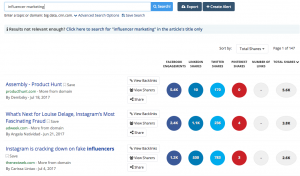Influencer marketing is a not-so-new concept that is rapidly becoming a mainstream marketing tool. Analysis of Google Keywords and Google Trends reveal how interests in the concept have surged more than 90x since 2013.
Why?
According to Deloitte’s survey, 47% of Millennials confirm that social media influences their purchasing decisions. While 73%, “others,” consider it a responsibility to guide friends, peers, and family toward smart purchase decisions.
Let’s face it: between the moment of checking a product online and the seconds of entering credit card numbers, everything that happens is digital magic. Luckily, in situations where this magic is an uphill struggle for marketers, it’s always good to know that online influencers—who have the public trust—have the wand to help them out.
[bctt tweet=”When marketing becomes an uphill struggle, it’s appealing that online influencers can help you out.” username=”@akorive001″]
So, how do you get help from these celebrities? Simple. Create the following pillars right now. Then develop them onwards and upwards.
#1 Finding Potential Influencers for a Mutually Beneficial Relationship
In influencer marketing, you have the best chance to beat your competition, hands down. That’s when you’re doing it the right way, however.
So let me show you the most effective ways.
According to Neil Patel, finding influencers in trending topics related to your niche and brand is the first step. You need these celebrities if you want to increase your brand awareness and upscale sales. For instance, a bodybuilding supplement manufacturer needs influential fitness YouTubers for obvious reasons.
The hunt-and-peck method works well—looking for a potential influencer. This means searching online sites (e.g. BuzzSumo and LittleBird) or using software (e.g. inPowered and Traacker) to find trending content based on spot on keywords and the top influencers behind them, so as to start the connection process. These tools are good for tracking content metrics. But they can be used for a lot more, such as getting the actual weight of a particular influencer through the lens of their social followings and engagements.

Social media monitoring is another trick. Research frequently used hashtags to find the best fit among influencers. Also, you can absolutely rely on Google Alert.
At this stage, generally, you’re only looking for “influencers who match your brand’s values, who influence your target market, and who will promote your product with passion,” as noted by Murray Newlands. You’re actually doing this because customers are more likely to accept recommendations from a trusted and respected personality than ads. In fact, “consumers trust recommendations from a third party more often than a brand itself.”
Here’s how to establish a long-term, results-driven relationship whenever you find one:
- Engage them on their platforms. Comment on and share their posts, including blogs and social handles. Influencers say this is the best way to grab their attention.
- Send an irresistible cold pitch. Your pitch must be 100% irresistible.
- Follow up like a Pro. If your first shot missed the target, give it another shot, focusing on format, content, tone, and timing.
#2 Marketing to Influencers
In order to have influencers on your side , you should market first to them. “The more influencers love your product, the easier it will be for them to promote it,” says Murray.
As such, how you present your product or service to an influencer really matters a lot.
Combining the first and second processes together, influencer marketing is all about relationship building. You develop a rapport with online authorities to create visibility for your product or service. “Unlike other marketing approaches that focus on “masses,” this approach focuses on the individual influencers, who can range from niche bloggers to well-known celebrities,” says Brian Sutter.
As a matter of advice, Murray notes that an influencers’ opinion must be respected, always. Give them creative control and respect, acknowledging that they’re influencers because people respect, trust and listen to them.
#3 Marketing Through and with Influencers
Find an influencer; build the relationship, market to the newly found celebrity—all said and done. What’s next? Marketing to the target customers through or with the influencer is what.
If you’re marketing through, you’re using an influencers’ platforms to either create awareness by showcasing your expertise, service or product. This often takes the form of guest posts. On the other hand, you can host them, be it podcasts or a special interview/feature on your platform.
But in the case of marketing with, it means you want influencers as advocates. It’s simple. The goal—having successfully carried out process one and two—is to have them talk about your product or service in one or more of their posts and/or tutorials. You can as well ask them to review your product or service. Beyond these, influencers are effectively used as a spokesperson, connector, reporter etc.
Either way, influencer marketing is sure-fire magic. A TapInfluencer 2016 study jointly conducted with Nielsen Catalina Solutions reports that influencer marketing content delivers 11x higher ROI than traditional forms of digital marketing.
This is a Contributor Post. Opinions expressed here are opinions of the Contributor. Influencive does not endorse or review brands mentioned; does not and cannot investigate relationships with brands, products, and people mentioned and is up to the Contributor to disclose. Contributors, amongst other accounts and articles may be professional fee-based.

